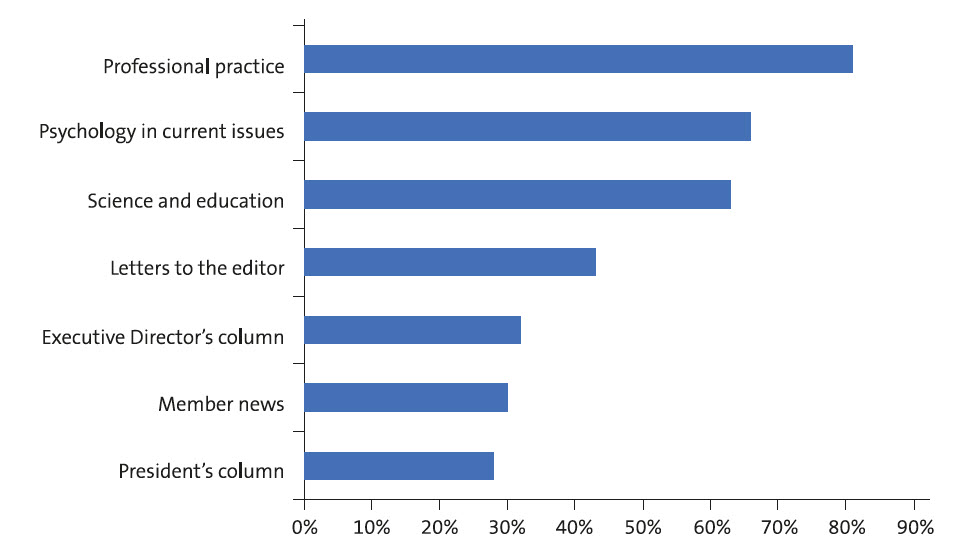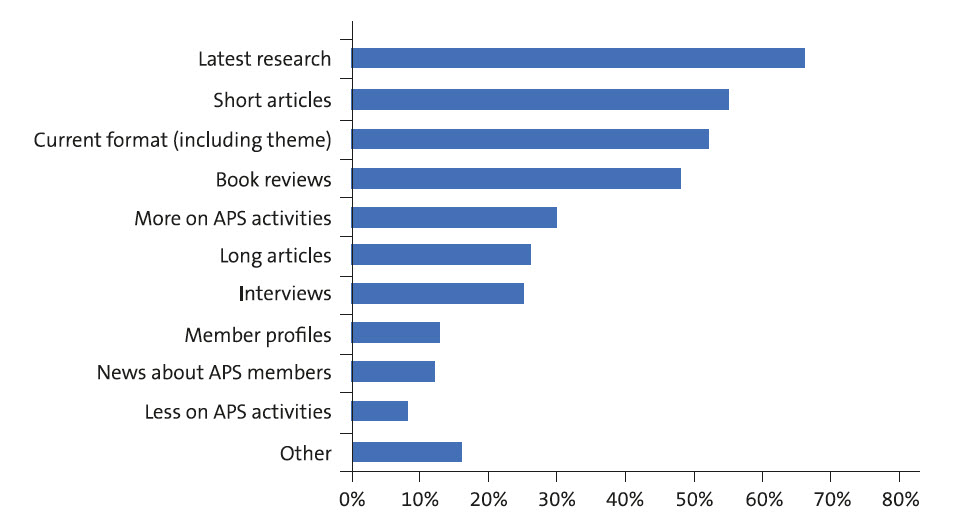In April we conducted an online survey and a series of focus groups to gather feedback from members on what they would like to see in InPsych. The results have been incorporated into our plan to refresh the APS’s flagship publication in 2018. The review of InPsych will not only update the visual ‘look and feel’ of the magazine, but revise its structure and include a range of new columns and features. The primary goal of this review is to broaden the magazine’s appeal for our diverse member-base, and explore topics of interest to researchers, practitioners and students alike. Another important focus of the redesign is to bring it into line with similar publications in the field of psychology. In doing so, InPsych will continue to grow and be a relevant, engaging ‘voice’ for psychology in Australia.
Seeking member input
Nineteen members, recruited through an earlier survey undertaken by the APS Institute, took part in three focus groups held in February and a total of 651 members responded to an online survey distributed to all members as a web link in an email.
The focus groups and survey sought member input about the content, look and feel of InPsych including, what they like about InPsych, how they access InPsych, suggestions for improving the content and presentation of InPsych, and content ideas.
Member feedback
Overall, the focus group and survey feedback was positive with 69 per cent of respondents rating InPsych as either an excellent or good source of information about psychology generally and 74 per cent as an excellent or good source of information about the APS. This view was supported by many open-ended comments such as, “it helps me to feel connected to the profession” and “it provides a balance between the things that members need to know and other interesting articles”. Many members indicated that they particularly like the practical content with the Psych Alert and Comfortably Compliant columns specifically mentioned.
When asked about their preference for reading InPsych online versus in hard copy, most respondents reported that they read InPsych in hard copy format (74%) with only four per cent reporting that they read the online version and 22 per cent indicating that they read a mix of both. Many members who currently read the hard copy of InPsych indicated that they would move to an online version if the website made InPsych more accessible and user-friendly; however, over a third of respondents reported that they are unlikely to use digital technology to access InPsych.
Current and future content
Almost 80 per cent of survey respondents rated the range of topics for the cover theme in InPsych as excellent or good. The current version of InPsych is organised in regular features and Figure 1 shows ratings of either high or excellent with regards to the value of these columns to members. Consistent with key messages in the survey and focus groups, professional practice issues were rated the highest area of value.
There were many suggestions about content that members would like to see in the future. Figure 2 provides member responses to potential articles to be included in InPsych and demonstrates member’s interest in research-based articles, followed by short articles on a range of topics. Considerable support remains for the current format of having a key theme and almost half of the members who took part in the survey would like to see book reviews included in InPsych. These results were reinforced in the open-ended survey and focus group comments which provided a better understanding of what members would like to get from InPsych. Examples of these comments are provided in the following paragraphs.
There were many comments on the need to include more research-based articles and brief research updates such as “more information from a scientific perspective”, “the latest research”. As already indicated, practice content was a key theme with members seeking “more from practising psychologists and how they use current research” and information “on therapeutic practices” and “changes in assessment – new approaches”.
Many members want to see more diversity in content with comments like “less focus on clinical content”, “different areas of psychology being explored”, “information across a range of practice areas and in a range of practice contexts” and “content that reflects the diversity of psychology practice”.
Although there was support for retaining the current format of several longer articles on a key theme, members also indicated that they would like to see “shorter articles with key take-away learning” and that “rather than one topic area include several shorter articles so there is greater diversity in the one issue”. Another feature of the feedback was the communication style of the articles with members wanting InPsych to be made up of “sharper, succinct and punchy articles” and to be “more chatty and engaging”, “more magazine style”. In addition, there were calls for increasing the scope for sharing information through for example, longer letters and more opportunities for members to share experiences and learning.
Future topic areas
Many ideas were forthcoming from members about topic areas to be covered in InPsych. These suggestions are enormously valuable and will be used for planning future articles. Some of the suggested topics included:
- Psychologists working in atypical roles and settings
- Forensic issues such as preparing reports for court and client competence to plead
- Specific clinical topics and disorders (e.g., eating disorders, impulse control disorders, interventions)
- Technology and psychology
- Legal and ethical issues
- Child issues (e.g., parenting, school refusal)
- Sexuality and gender-based issues
Redesign: An update of the ‘look and feel’
One of the key responses from members was a desire for ”more of a magazine-style format” with a “modernised” design. Both The British Psychological Society’s The Psychologist and the American Psychological Association's The Monitor appeared frequently in responses as a possible direction for InPsych in terms of a new-look design. To that end, our design consultant and in-house design team are working on modernising the look of the overall design, and updating both the paper stock and size of the magazine to be in keeping with current design trends. The new design will incorporate more images, infographics, offer greater legibility, and make better use of white space and other elements that enhance readability.
This opportunity to ‘refresh’ the publication is being undertaken to improve both the legibility and appeal of InPsych. It will focus on a seamless flow between articles throughout, while retaining many of the regular features that members said they value the most. In terms of content, the most prominent change will be a move away from a single topic for the ‘cover feature’. Instead, we will focus on a ‘longer read’ feature article and a range of shorter articles encompassing a variety of topics. This will offer the editorial committee flexibility to commission and receive submissions on topics from a wider range of psychological fields.
Next steps
The feedback provided by members, along with various recommendations from the design consultant will guide the introduction of a new- look InPsych. We hope that new features, content and creative direction will be introduced over a period of time in 2018. We will tell you more in the December edition of InPsych, but one change we are implementing now is that member contributions for the February InPsych will reflect a broader range of content and type of articles. Read more about this in the call for contributions.
Figure 1. The percentage of members who indicated the InPsych columns or sections provided them with high or excellent value (a rating of 4 or 5).

Figure 2. The type of content members identified that they would like to see in InPsych.

- APS Manager Publications and Resources
- APS Senior Editor